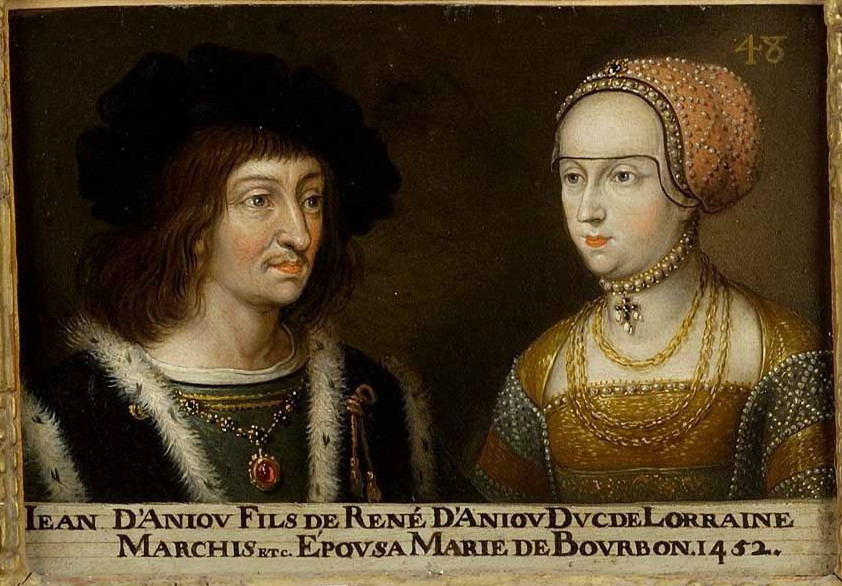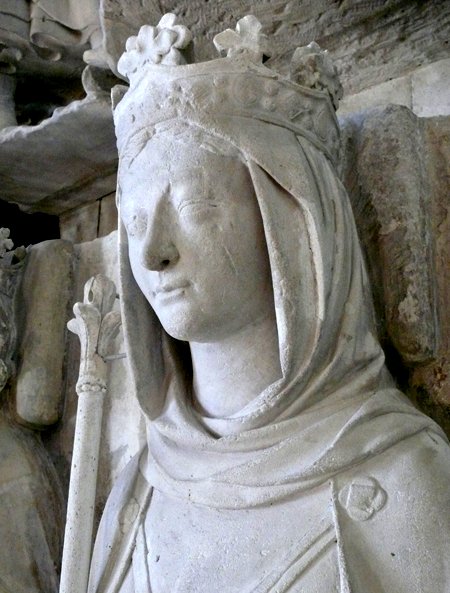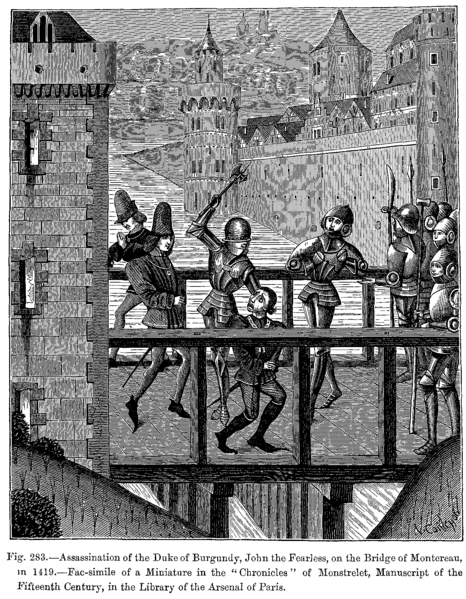|
John II Of Lorraine
John II of Anjou ( Nancy, August 2, 1426 – December 16, 1470, Barcelona) was Duke of Lorraine from 1453 to his death. He was the son of René of Anjou and Isabella, Duchess of Lorraine. He was married to Marie de Bourbon, daughter of Charles I, Duke of Bourbon. Duchy John inherited the duchy from his mother, Duchess Isabelle, during the life of his father, Duke René of Anjou, also Duke of Lorraine and titular king of Naples. As heir-apparent of Naples, he was styled the Duke of Calabria and spent most of his time engaging in plots for the Angevin recovery of Naples. In 1460, he decisively defeated the king of Naples Ferdinand at Nola, but was unable to prevent others from coming to his aid. He was defeated at Troia in 1462 and at Ischia in 1465. In 1466, the Catalans chose his father as King of Aragon, and he was created Prince of Girona, as heir-apparent. He went into Catalonia to press the family's claims, but died, supposedly by poison, in Barcelona. Personal In 1 ... [...More Info...] [...Related Items...] OR: [Wikipedia] [Google] [Baidu] |
Duke Of Calabria
Duke of Calabria was the traditional title of the heir apparent of the Kingdom of Naples after the accession of Robert of Naples. It was also adopted by the heads of certain Houses that had once claimed the Kingdom of Naples in lieu of the royal title. There are at present two claimants to the title of Duke of Calabria. In the Spanish context, it is the title for the head of the House of Bourbon-Two Sicilies, and in the French context it is the title for the heir to the Duke of Castro, the head of the Royal House. List of past dukes * bef. 1297–1309: Robert, son of Charles II * 1309–1328: Charles, son of Robert * 1333–1343: Joanna, daughter of Charles, jointly with her husband Andrew of Hungary * 1343-1345: Andrew of Hungary, as husband of Queen Joanna I * 1345-1348: Charles Martel, son of Andrew and Joanna I House of Anjou * 1381–1382 Louis I of Naples * 1382–1384 Louis II of Naples * 1403–1417 Louis III of Naples * 1426–1434 Louis III of Naples * 1434–1435 ... [...More Info...] [...Related Items...] OR: [Wikipedia] [Google] [Baidu] |
County Of Anjou
The County of Anjou (, ; ; la, Andegavia) was a small French county that was the predecessor to the better-known Duchy of Anjou. Its capital was Angers, and its area was roughly co-extensive with the diocese of Angers. Anjou was bordered by Brittany to the west, Maine to the north, Touraine to the east and Poitou to the south. The adjectival form is Angevin, and inhabitants of Anjou are known as Angevins. In 1360, the county was raised into the Duchy of Anjou within the Kingdom of France. This duchy was later absorbed into the French royal domain in 1482 and remained a province of the kingdom until 1790. Background Anjou's political origin is traced to the ancient Gallic state of the ''Andes''. After the conquest by Julius Caesar, the area was organized around the Roman '' civitas'' of the ''Andecavi''. History Frankish county The Roman civitas was afterward preserved as an administrative district under the Franks with the name first of ''pagus''—then of ''comitatus'' or ... [...More Info...] [...Related Items...] OR: [Wikipedia] [Google] [Baidu] |
Francesco Laurana, Medaglia Di Jean D'anjou, 1464
Francesco, the Italian (and original) version of the personal name "Francis", is the most common given name among males in Italy. Notable persons with that name include: People with the given name Francesco * Francesco I (other), several people * Francesco Barbaro (other), several people * Francesco Bernardi (other), several people *Francesco di Giorgio Martini (1439-1501), Italian architect, engineer and painter * Francesco Berni (1497–1536), Italian writer * Francesco Canova da Milano (1497–1543), Italian lutenist and composer * Francesco Primaticcio (1504–1570), Italian painter, architect, and sculptor * Francesco Albani (1578–1660), Italian painter * Francesco Borromini (1599–1667), Swiss sculptor and architect * Francesco Cavalli (1602–1676), Italian composer * Francesco Maria Grimaldi (1618–1663), Italian mathematician and physicist * Francesco Bianchini (1662–1729), Italian philosopher and scientist * Francesco Galli Bibiena (1659 ... [...More Info...] [...Related Items...] OR: [Wikipedia] [Google] [Baidu] |
House Of Valois-Anjou
The House of Valois-Anjou (, it, Casa Valois-Angiò) was a noble French family and cadet branch of the House of Valois. Members of the house served as monarchs of Naples, as well as several other territories. History The house was founded in the 1350s, when King John II of France, of the Valois line of Capetians, came to power. His paternal grandmother, Countess Margaret of Anjou and Maine, had been a princess of the Capetian House of Anjou or Elder Angevin Dynasty. She was the eldest daughter of King Charles II of Naples and gave Anjou to the second son of king John II of France, Louis. Within a couple of decades, Queen Joan I of Naples, also of the senior Angevin line, realized that she would remain childless. Although there were extant heirs of the senior branch, for example, the Anjou-Durazzo cadet line, she decided to adopt Louis as her final heir. Thus, in addition to the struggle of the Angevins with Aragon in Southern Italy, the two Angevin lines, senior and junior, no ... [...More Info...] [...Related Items...] OR: [Wikipedia] [Google] [Baidu] |
List Of Consorts Of Lorraine
The royal consorts of the rulers of the Lorraine region have held varying titles, over a region that has varied in scope since its creation as the kingdom of Lotharingia by the Treaty of Prüm, in 855. The first rulers of the newly established region were kings of the Franks. The Latin construction "Lotharingia" evolved over time into "Lorraine" in French, "Lotharingen" in Dutch and "Lothringen" in German. After the Carolingian kingdom was absorbed into its neighbouring realms in the late ninth century, dukes were appointed over the territory. In the mid-tenth century, the duchy was divided into Lower Lorraine and Upper Lorraine, the first evolving into the historical Low Countries, the second became known as the Duchy of Lorraine and existed well into the modern era. Queen consort of Lotharingia Carolingian Dynasty, 855–922 Duchess consort of Lorraine House of Ardennes-Metz, 959–1033 Duchess consort of Lower Lorraine Matfriding dynasty, 959–973 *Interregnum ... [...More Info...] [...Related Items...] OR: [Wikipedia] [Google] [Baidu] |
House Of Bourbon
The House of Bourbon (, also ; ) is a European dynasty of French origin, a branch of the Capetian dynasty, the royal House of France. Bourbon kings first ruled France and Navarre in the 16th century. By the 18th century, members of the Spanish Bourbon dynasty held thrones in Spain, Naples, Sicily, and Parma. Spain and Luxembourg have monarchs of the House of Bourbon. The royal Bourbons originated in 1272, when the youngest son of King Louis IX married the heiress of the lordship of Bourbon. Anselme, Père. ‘'Histoire de la Maison Royale de France'’, tome 4. Editions du Palais-Royal, 1967, Paris. pp. 144–146, 151–153, 175, 178, 180, 185, 187–189, 191, 295–298, 318–319, 322–329. (French). The house continued for three centuries as a cadet branch, serving as nobles under the Direct Capetian and Valois kings. The senior line of the House of Bourbon became extinct in the male line in 1527 with the death of Charles III, Duke of Bourbon. This made the junior Bour ... [...More Info...] [...Related Items...] OR: [Wikipedia] [Google] [Baidu] |
Philip The Good
Philip III (french: Philippe le Bon; nl, Filips de Goede; 31 July 1396 – 15 June 1467) was Duke of Burgundy from 1419 until his death. He was a member of a cadet line of the Valois dynasty, to which all 15th-century kings of France belonged. During his reign, the Burgundian State reached the apex of its prosperity and prestige, and became a leading centre of the arts. Philip is known historically for his administrative reforms, his patronage of Flemish artists such as van Eyck and Franco-Flemish composers such as Gilles Binchois, and perhaps most significantly the seizure of Joan of Arc, whom Philip ransomed to the English after his soldiers captured her, resulting in her trial and eventual execution. In political affairs, he alternated between alliances with the English and the French in an attempt to improve his dynasty's powerbase. Additionally, as ruler of Flanders, Brabant, Limburg, Artois, Hainaut, Holland, Luxembourg, Zeeland, Friesland and Namur, he played an i ... [...More Info...] [...Related Items...] OR: [Wikipedia] [Google] [Baidu] |
John The Fearless
John I (french: Jean sans Peur; nl, Jan zonder Vrees; 28 May 137110 September 1419) was a scion of the French royal family who ruled the Burgundian State from 1404 until his death in 1419. He played a key role in French national affairs during the early 15th century, particularly in the struggles to rule the country for the mentally ill King Charles VI, his cousin, and the Hundred Years' War with England. A rash, ruthless and unscrupulous politician, John murdered the King's brother, the Duke of Orléans, in an attempt to gain control of the government, which led to the eruption of the Armagnac–Burgundian Civil War in France and in turn culminated in his own assassination in 1419. The involvement of Charles, the heir to the French throne, in his assassination prompted John's son and successor Philip to seek an alliance with the English, thereby bringing the Hundred Years' War to its final phase. John played an important role in the development of gunpowder artillery in E ... [...More Info...] [...Related Items...] OR: [Wikipedia] [Google] [Baidu] |
Agnes Of Burgundy, Duchess Of Bourbon
Agnes of Burgundy (1407 – 1 December 1476), duchess of Bourbon (Bourbonnais) and Auvergne, countess of Clermont, was the daughter of John the Fearless (1371–1419) and Margaret of Bavaria. Her maternal grandparents were Albert I, Duke of Bavaria and Margaret of Brieg. Her paternal grandparents were Philip the Bold and Margaret III, Countess of Flanders. Marriage and issue Agnes married Charles I, Duke of Bourbon.Leguai, André, "Agnès de Bourgogne, duchesse de Bourbon (1405?-1476)," in ''Les ducs de Bourbon, le Bourbonnais et le royaume de France à la fin du Moyen Age'' (Société bourbonnaise des études locales: Yzeure, 2005), 145-60. They had: * John of Bourbon (1426–1488), Duke of Bourbon * Marie de Bourbon (1428–1448), married in 1444 John II, Duke of Lorraine * Philip of Bourbon (1430–1440), Lord of Beaujeu * Charles of Bourbon (Château de Moulins 1434–1488, Lyon), Cardinal and Archbishop of Lyon and Duke of Bourbon * Isabella of Bourbon (1436–1465), ... [...More Info...] [...Related Items...] OR: [Wikipedia] [Google] [Baidu] |
Catalonia
Catalonia (; ca, Catalunya ; Aranese Occitan: ''Catalonha'' ; es, Cataluña ) is an autonomous community of Spain, designated as a ''nationality'' by its Statute of Autonomy. Most of the territory (except the Val d'Aran) lies on the northeast of the Iberian Peninsula, to the south of the Pyrenees mountain range. Catalonia is administratively divided into four provinces: Barcelona, Girona, Lleida, and Tarragona. The capital and largest city, Barcelona is the second-most populated municipality in Spain and the fifth-most populous urban area in the European Union.Demographia: World Urban Areas – Demographia, April 2018 Current day Catalonia comprises most of the medieval and early modern Principality o ... [...More Info...] [...Related Items...] OR: [Wikipedia] [Google] [Baidu] |
Ischia, Campania
Ischia is a town and ''comune'' on Ischia island in the Tyrrhenian Sea. Administratively it is part of the Metropolitan city of Naples, in the Campania region in southern Italy. It is famed for its thermal baths due to the volcanic nature of the island. Overview The main centre of the ''comune'' is divided between Ischia Porto and Ischia Ponte. The latter takes its name from a former wooden bridge (''ponte'') which, until the 18th century, connected it to the Aragonese Castle. Twin towns * Marino, Italy * San Pedro, California, United States * Mar del Plata, Argentina Argentina (), officially the Argentine Republic ( es, link=no, República Argentina), is a country in the southern half of South America. Argentina covers an area of , making it the second-largest country in South America after Brazil, th ... References External links Official Comune Ischia website�� . Coastal towns in Campania Cities and towns in Campania {{campania-geo-stub ... [...More Info...] [...Related Items...] OR: [Wikipedia] [Google] [Baidu] |
Troia, Apulia
Troia (also formerly Troja; nap, label= Foggiano, Troië; grc, Αῖκαι, Aîkai; la, Aecae) is a town and ''comune'' in the province of Foggia and region of Apulia in southern Italy. History According to the legend, Troia (Aecae) was founded by the Greek hero Diomedes, who had destroyed the ancient Troy. Aecae was mentioned both by Polybius and Livy, during the military operations of Hannibal and Quintus Fabius Maximus Verrucosus in Apulia. In common with many other Apulian cities it had joined the Carthaginians after the battle of Cannae, but was recovered by Fabius Maximus in 214 BC, though not without a regular siege. Pliny also enumerates the Aecani among the inland towns of Apulia (iii. 11); but its position is more clearly determined by the Itineraries, which place it on the Appian Way between Aequum Tuticum and Herdonia, at a distance of from the latter city. This interval exactly accords with the position of the modern city of Troia, and confirms the statements of ... [...More Info...] [...Related Items...] OR: [Wikipedia] [Google] [Baidu] |





